Really small SUVs aren’t a new idea. You may remember old school examples like the Geo (later Chevy) Tracker of the ’90s, as a for-instance.
But the idea’s making a comeback.
And it’s not a bad idea . . . if you’re looking for SUV capabilities (and capacities) in something with a footprint that’s about the same size as a subcompact sedan’s.
The Eco Sport is Ford’s newest – and smallest – crossover SUV.
It’s about a foot-and-a-half shorter overall than the Escape, formerly Ford’s smallest SUV – so it can fit into tight curbside parking spots the Escape, larger SUVs – and most cars – have to pass up.
But it isn’t tight inside.
There’s several inches more backseat legroom in this mini-me SUV than in most same-length subcompact sedans – and about three times the cargo capacity.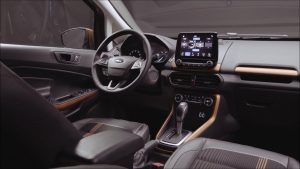
It also has more ground clearance – almost eight inches – than other mini-me SUVs and it’s the only mini-me SUV with a swing-out (rather than swing up) rear door.
Base price is $19,995 for the front-wheel-drive S trim equipped with a turbocharged three cylinder engine paired with a six-speed automatic. A larger 2.0 liter four cylinder engine (no turbo) is available optionally – and with or without all-wheel-drive.
A top-of-the line Titanium trim equipped with the 2.0 liter engine and AWD stickers for $27,330.
The Eco Sport has been available in Europe for several years but it’s a new model for the U.S. market.
Ford brought it over to counter the growing ranks of similar models from Honda (HR-V), Mazda (CX-3), Chevy (Trax) and – most recently – the just-launched Toyota C-HR.
WHAT’S GOOD
About 7 inches shorter overall than Honda HR-V and Mazda CX-3 – so it fits in even tighter spots.
Several inches more backseat legroom than the Deep Vein Thrombo Toyota C-HR.
The extra almost two inches of ground clearance gives it a snow-day edge over lower-to-the-ground competitors.
Heavier than others in this class, which hurts both Eco and Sport.
Base-engined models are FWD-only.
High-mileage diesel engine that’s available in European Eco Sports isn’t going to be available here.
UNDER THE HOOD
The Eco part of the deal – for the U.S. – is the standard 1.0 liter, three cylinder engine. in theory, this very small engine – it’s the only three cylinder engine in the class – shouldn’t use much gas. Less gas, at least, than a larger four cylinder engine would.
Except it doesn’t.
The sticker says 27 city, 29 highway – as opposed to 29 city, 34 highway for the larger-engined (2.0 liters) Mazda CX-3 with FWD and 27 city, 31 highway for the similarly better-endowed 1.8 liter-equipped Honda HR-V with all-wheel-drive.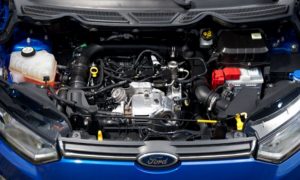
The three cylinder-powered Ford is front-drive-only.
Part of the reason for this is that the Ford is heavy – 3,021 lbs. as it sits.
The Honda weighs about the same – 3,094 lbs. – but it has almost twice the engine, in terms of physical displacement.
The Ford can increase its functional displacement on demand – via the turbo that’s bolted to its exhaust manifold. It boosts the output of the little three to almost four – 123 hp (the Honda’s larger 1.8 liter engine makes 141 hp; the Mazda’s 2.0 liter engine makes 146).
But there’s the rub.
Off the boost, the 1 liter engine doesn’t make enough power to haul the 3,000-plus pound FWD Eco Sport. So it’s on boost pretty much whenever the Eco Sport is moving . . . in order to get it moving. But that eats gas – which defeats the purpose of having the smaller engine.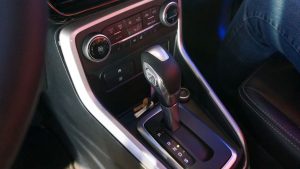
With a caveat.
The 1.0-equipped Eco Sport is more economical in stop-and-go city driving than the Eco Sport equipped with the optional 2.0 liter four cylinder engine. Both rate the same 29 MPG on the highway – but the smaller-engined version’s city mileage (27 MG) is four MPG better than the bigger-engined version’s (23 MPG).
But, you can’t get the 1.0 liter engine with AWD – because adding roughly 200 pounds to the Eco Sport’s curb weight would have that little engine working hard (on boost) pretty much all the time.
Chevy splits the difference with a 1.4 liter four cylinder engine that’s not too small – with a turbocharger to make it just a little bigger when needed. It makes 138 hp – enough to handle the optional AWD system and still manage 25 city, 33 highway for the FWD version.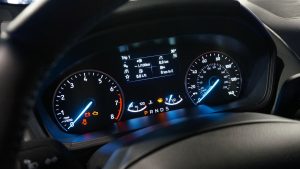
If you want an AWD Eco Sport, you’ll be upgrading to the optional 2.0 liter four cylinder engine. It has the gumption – 166 hp – to handle the additional couple hundred pounds the AWD system adds.
Or, skip the AWD and get to 60 a little sooner.
And the bigger engine makes its power without a turbo – which is arguably long-haul/post-warranty preferable. Turbocharged engines can be built tough, to handle the boost – but no matter how well-built, they have more parts (the turbo, of course – plus the peripherals and plumbing) and that means the potential, at least, for more things to go wrong eventually.
Those odds going up as the miles go by.
The Ford also uses a pretty conventional six-speed automatic – with both engines. It’s not “the latest thing” – but that, too, is arguably a good thing. If you are planning on keeping this thing for a long time.
Equipped with the 2.0 liter engine, the Eco Sport can pull up to 2,000 lbs. – the same as the Mazda CX-3 and 2,000 lbs. more than the Honda, which isn’t rated to tow anything.
The Trax is rated to pull as much as 3,200 lbs. – best in class – but it seems iffy given the maximum 138 hp under its hood.
The Eco Sport isn’t the quickest in this class – it takes about 10 seconds to mosey to 60 MPH, even with its strongest-in-class (on paper) 2.0 liter engine – vs. 8-9 seconds in lighter rivals like the HR-V and CX-3.
But it is the most adverse weather capable – chiefly because of its higher ground clearance.
In heavy snow, that matters at least as much as whether you’ve got AWD – because once your car rides up on top of the snow, you’re stuck.
This mini-me SUV also has a very tight turning circle – 17.5 feet – which is about two feet tighter than an Escape’s. That makes it easy to U turn on narrow streets in a single fluid motion – no having to stop, reverse and reposition.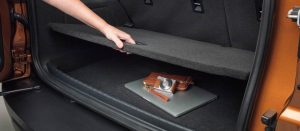
But the real surprise is how stable it feels given how short and tall it is.
What killed off the the original crop of mini-me SUVs like the Geo Tracker was their top-heavy handling and tendency to end up on their tops after being unsettled by an abrupt jerk of the steering wheel – as when trying to avoid an animal or kid that unexpectedly appeared in the road.
Despite its very short 99.2 inch wheelbase – only slightly longer than a ’95 Chevy Tracker’s 97.6 inch wheelbase. And despite being almost exactly the same height – 65 inches for the Eco Sport vs. 65.7 for the ’90s-era mini-me SUV. Part of the reason for the difference is the Eco Sport’ strut-type four-wheel-independent suspension vs. the old-school mini-me’s less-forgiving coil spring set-up.
And, of course, stability control wasn’t on the roster back in ’95. It’s standard equipment now.
The only issue the Eco Sport does have is a jouncy-bouncy ride, the almost-inevitable result of that 99.2 inch wheelbase plus all that weight.
What goes up must come down.
The Eco Sport is only 161.3 inches long.
To get a sense of how short that is, a subcompact sedan like the 2018 Hyundai Accent is almost a foot longer overall (172.6 inches).
But the Accent only has 33.5 inches of backseat legroom – and a 13.7 cubic foot trunk.
The Eco Sport has 36.7 inches of backseat legroom – comparable to the legroom in many mid-sized cars – and 50 cubic feet of cargo capacity with its backseats folded flat. Even with them up, you still have 20.9 cubic feet of cargo carrying space.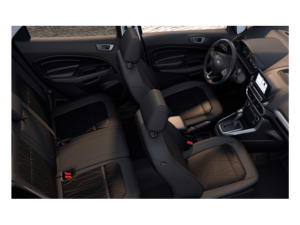
That’s more cargo space than the Chevy Trax (18.7 cubic feet behind its back seats and 48.4 inches with the second row folded) and 5 inches more backseat legroom than the Toyota C-HR (31.7 inches – that’s tight!)
The Honda HR-V has the most interior and cargo space of them all – including 39.3 inches of second row legroom – comparable to the legroom in some full-sized cars -and 23.2 cubic feet of cargo space behind the second row.
With the second row down, the HR-V’s cargo capacity increases to a class-best 58.8 cubic feet.
The Mazda CX3, on the other end of the scale, has the least cargo space of them all – just 12.4 cubic feet with the second row up. That’s less cargo space than a Hyundai Accent subcompact sedan (13.7 cubic feet).
There’s one thing the Ford’s got that none of the others do – a swing-out cargo door. If you’re tall, your won’t bump your head against the door. And if you’re not tall, reaching the door handle (to open and close the door) is easier than it is with a traditional swing-up liftgate.
On the downside, the swing-out door can be harder to open if you’re jammed into a tight parking spot.
The up-swinging liftgate makes use of vertical space.
Regardless, having a big door makes the available space more accessible. You can stuff long/stuff into one of these things – and then close the door. You can’t stuff nearly as much stuff in a car’s trunk – and even if you get it part of the way in there, it’s going to be hanging in the breeze.
And the rain.
Another nice touch is the cargo area’s configurable shelving – and the hidden storage area underneath the shelving.
THE REST
You can get this mini-me SUV with almost everything imaginable – including an outstanding 10-speaker Bang & Olufsen ultra-premium audio system. All trims get an LCD touchscreen – ranging in size from 4.2 inches in the base S trim to 6.5 inches in the mid-trim SE – with an 8 inch unit available optionally.
You can also get an external keypad entry system – a uniquely Ford (and Lincoln) feature you won’t find anywhere else. It’s a nice fail-safe in the event you lock yourself out or just can’t find your keys.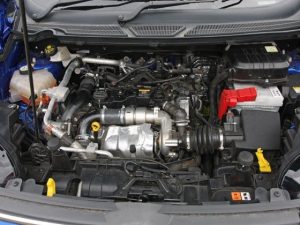
A windshield wiper de-icer and ambient interior lighting are also available. All trims come standard with two USB ports (located ahead of the shifter) and – on SE and higher trims – a 110V household style power point.
The one thing you can’t get is the turbodiesel engine Ford offers in European-spec version of this vehicle.
That’s too bad, because the euro-spec diesel is capable of averaging 10 MPG better than either of the U.S.-spec Eco Sport’s gas engines.
But Ford – like other automakers – is reluctant to bring a diesel engine to the U.S. in the wake of the VW diesel debacle.
Hopefully, when the smoke clears, that will change.
THE BOTTOM LINE
Big things sometimes come in small packages!
. . .
Got a question about cars – or anything else? Click on the “ask Eric” link and send ’em in!
If you like what you’ve found here, please consider supporting EPautos.
We depend on you to keep the wheels turning!
Our donate button is here.
If you prefer not to use PayPal, our mailing address is:
EPautos
721 Hummingbird Lane SE
Copper Hill, VA 24079
Our donate button is here.
If you prefer not to use PayPal, our mailing address is:
EPautos
721 Hummingbird Lane SE
Copper Hill, VA 24079
PS: EPautos magnets are free to those who send in $20 or more. Also, my latest eBook is also available for your favorite price – free! Click here. 


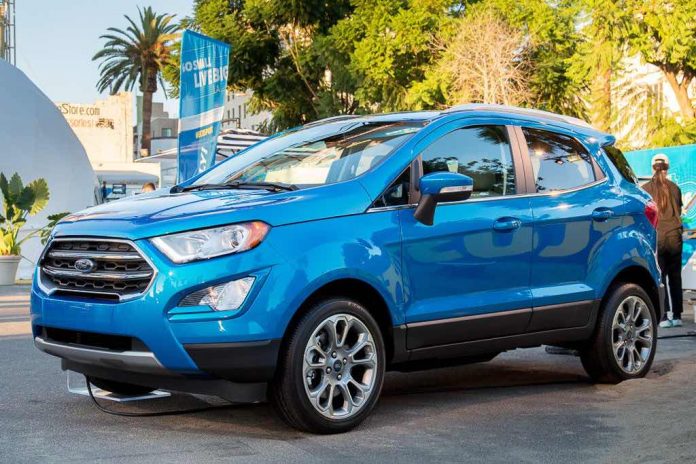

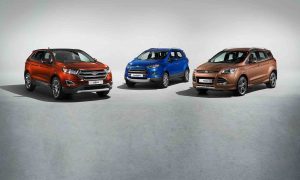
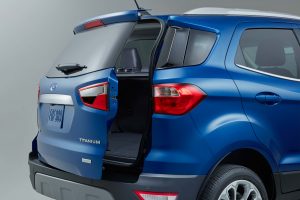

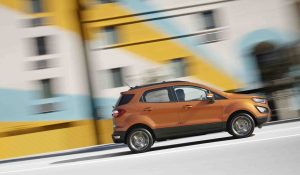

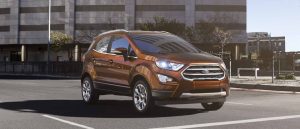
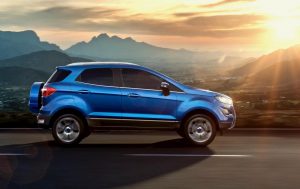








The side-swing cargo door is something people will have to get used to. On the GX I have to remember not to pull through the parking spots at Costco, because if someone is parked directly behind me I won’t be able to get the door open all the way.
At least with the Ford it’s left-hand-drive friendly with the cargo door hinge on the left, so you can open it from the curb and not be loading it from out in the road.
The styling is what gets me. It’s like they took a compact car and welded it on top of the bottom 1/3 of another one. They’ve tried to hide it with the black trim along the door sills, but once you see it, it can’t be unseen.
Nissan is selling the piss out of Rogues. So many of them on the road here in Houston. Like the Hyundai Tuscon when it first debuted, it was quite popular. Ford is late to the game and a dollar short.
“Part of the reason for this is that the Ford is heavy – 3,021 lbs. as it sits.”
For a subcompact. This is where we are.
1989 Geo Tracker: 2,260 lbs. 26 mpg average city+highway.
How far we’ve come indeed.
https://www.cars.com/reviews/los-angeles-timess-view-1420689076529/
That’s 761 pounds of now mandatory (or defacto mandatory) crap most adult males would never voluntarily purchase in 30 years time.
761 lbs / 2,260 lbs = 34% fatter.
The overwhelming majority of people never experience a major accident their entire lives.
So basically, 3 fat dudes are hitching a mandatory ride with all of us – “for safety.”
But – I can rock climb without a harness. And I can buy a 200 mph motorcycle and ride without a helmet.
Our masters know best. Got it. Nice.
Hi Blake,
“…. crap most adult males would never voluntarily purchase in 30 years time.”
Exactly.
The Safety Cult is an offshoot of the feminization of the culture. Anyone old enough to remember even the ’80s knows how far things have gone south. In those days, most guys would openly mock anyone obsessed with saaaaaaaaaaaaaaaaaaaaaafety. Such people were geeks and losers and other words we’re not supposed to use today.
I can’t put my finger on it exactly, but it all began to change when the “baby on board” signs started to crop up. The language shifted. Slowly, but inexorably.
Fast forward 30 years and the saaaaaaaaaaaaaafety jabber is the ubiquitous preface to almost every discussion – not just about cars.
Why don’t men resist, fight back – mock?
It’s because they don’t want to upset women; they want to get laid. They want their wives to be “happy.” And have been browbeaten to believe that worshipping saaaaaaaaaaaaaaaaaaaaaaafety is the key to that, because their women say so.
I think the term is “pussywhipped”, correct me if I’m wrong.
I told my wife it was for safety to buy some new control arms, tie rods, shocks, struts, and an aFe performance exhaust for our suv 🙂
Hi Brazos,
I used to do that… back when I had a wife!
There must be a rational reason for the Ford Eco weighing more than similar cars from other auto makers.
Hi Jone,
It actually weighs about the same as one of its main rivals – the Honda HR-V. But the Honda comes standard with a larger (almost twice as large) four cylinder engine to compensate.
The Ford’s turbo three could deliver better mileage were it not necessary to call up the boost pretty much all the time… because of the weight of the vehicle it’s in.
PS: Glad to see you’re still lurking 🙂
The 1.0 liter turbo triple sounds like a real turd. My BIKE is an 1100cc four!! The 2.0 Ford DFI four is a really, really great engine and should be standard equipment on this thing.
Unfortunately, this SUV looks to be the replacement for the Focus, but the sticker price of the SUV with the four cylinder will be about four thousand bucks higher…. 🙁
Hi X,
It’s not that the engine is bad; it’s that this thing is way overweight for that engine. 3,000-plus pounds – for the base FWD version, before the driver or anyone else gets in and before anything gets put in the cargo area. So, figure at least 3,200 pounds with just the driver – and around 3,600-plus with four people on board.
And 123 hp under the hood.
That is a bad power-to-weight ratio!
That turbodiesel we can’t buy would answer the problem – because it has the torque of a V6, which is what this thing really needs.
But that’s no dice – for us, at least.
Sounds like a speed demon compared to my 1982 VW Diesel Vanagon Camper. 48hp pushing 4200 pounds. I’m shocked more weren’t made. ?
Hi Bill!
This is Pravda… all new cars are speed demons compared with the stuff you and I remember from our misspent youth. Even my Trans-Am was barely quicker than a current four cylinder family sedan.
But, no air bags or peremptory saaaaaaaaaaaaaaaafety features!
I have a customer that owns a 1st generation Suzuki Samurai. When he bought it the gas tank was leaking and the fuel gauge didn’t work, plus about a dozen other things that kept it from being road legal, like a complete floor pan, lol! But he fixed the fuel tank and rides it around on his 100 acre farm, kinda like a sport-tractor with overdrive!
What we all really need is this:
http://blog.udn.com/medov/4398479
Welcome to the world of insanely rich pricks! Meet our son, the next dictator of the known universe! P.S. We don’t pay taxes, too bad for you!
Now that Ford has declared sedans obsolete, will entry-level sedan/hatch buyers migrate to the more-expensive CUVs like the EcoSport?
Oh, BTW, there IS a 4X4 Smart, just not “standard production” yet:
https://theawesomer.com/smart-car-monster-truck/44534/
Who drives this, an Enviro-Redneck???
OH Look!!!!
It’s a Pocket SUV!!! What’s next, a Smart 4X4? Hahahahaha! Get hit in this thing and you WILL be kissing you ass goodbye, because that’s the position the coroner is going to find your corpse in! This makes me think of a picture I saw the other day, and I hesitated to post it then……but now I just have to give you the link:
https://imgur.com/gallery/JW82m
Yes, that WAS a 4-door Silverado! This just goes to show that whatever you drive, if it’s your time, your done! You had better damn well enjoy whatever you drive, because this is how we will all end up, eventually!
Looks like Ford is trying to take over the Kia Soul’s turf.
I predict Kia is going to kick its ass.